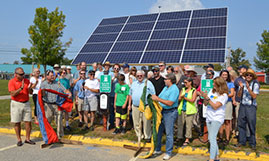Measures of Growth
Since 1994, MDF’s annual Measures of Growth has tracked 25+ indicators that provide a comprehensive snapshot of how Maine’s economy is faring.
Each year, MDF works with the Maine Economic Growth Council to develop the Measures of Growth Report. The indicators included collectively support the idea that Maine’s quality of life depends upon a vibrant and sustainable economy, thriving communities, and a healthy environment. Past performance and current conditions inform the establishment of future benchmarks for each indicator that are aspirational, potentially attainable and against which we can measure our collective progress.
For 2023, the Council assigns Gold Stars for significant progress in:
- Wages
- Postsecondary Degrees & Credentials
- Internet Connectivity
- Air Quality
- Water Quality
- Sustainable Forestlands
We assign Red Flags for needed attention to:
- Labor Force
- Research and Development
- Fourth-Grade Reading
- Eighth-Grade Math
- Cost of Energy
- State and Local Tax Burden
- Housing Affordability
- Mental and Behavioral Health
Fundamental Performance Indicators
Wages-1.5%
In 2022, wages remained above the EPSCoR average but fell 1.5% after adjusting for inflation.
Gender Income Equity+2%
in 2022, women’s median wages rose nearly 2% compared to men’s earnings, but remained about 84% of men’s earnings.
Racial/Ethnic Income Equity+3%
In 2017-2021, the average incomes of BIPOC* and Latino or Hispanic Mainers rose 3% but remained 31% below White Mainers, dramatically short of full equity. *Black, Indigenous, People of Color
Labor Force Participation-1.8%
In 2022, 81.0% of Maine adults ages 25-54 were in the labor force, down from 82.8% in 2021.
Value-Added-0.6%
In 2022, value-added per worker fell 0.6%, and was 22% below the U.S. average.
Gross Domestic Product+2%
In 2022, Maine’s GDP rose nearly 2%, on pace with other New England states.
Environment
Air Quality-4 Days
In 2022, there were 24 moderately unhealthy days, four fewer than last year.
Sustainable Forest Lands+8%
In 2021, the growth-to-harvest ratio rose 8% to 1.43 and remained above the sustainability goal.
Economy
Research & Development+0.1%
In 2020, Maine’s R&D spending rose from 1.0% to 1.1% of GDP.
Research & Development+0.1%
In 2020, Maine’s R&D spending rose from 1.0% to 1.1% of GDP.
International Exports+10%
Maine exports rose 10% in 2022, reaching their highest level since 2011.
Entrepreneurship+59%
In 2021, the number of business starts exceeded closures by 71%, up from 12% in 2020.
Fourth-Grade Reading-7%
In 2022, 29% of Maine 4th graders were proficient in reading, a sharp drop from pre-COVID levels.
Eighth-Grade Math-10%
In 2022, 24% of Maine 8th graders were proficient in mathematics, down from 34% pre-COVID.
Postsecondary Degrees and Credentials+2%
In 2021, 55% of Maine adults had a credential of value, up from 53% in 2019.
Cost of Health Care-0.7%
Proportional health care expenditures fell 0.7% in 2022 but remain an ongoing challenge.
Cost of Energy+17%
The price of industrial electricity rose 17% in 2022, mirroring nationwide increases.
Community
Internet Connectivity+8%
In 2023, 86% of Maine locations have either average or broadband internet, up 8%.
Housing AffordabilityTBD
Housing affordability appears to have dropped in 2022, but precise data are not currently available.
Physical Wellness+0.4%
Consistently, about 2/3 of Maine adults are overweight or obese.
Mental & Behavioral Health+0.4%
In 2020-2021, the percentage of children with a mental and/or behavioral condition rose 0.4%.
Health Insurance Coverage+1.2%
Maine’s health insurance coverage is stable and above the U.S. average.
Food Security-2%
In 2019-2021, the share of Mainers experiencing food insecurity fell about 2 percentage points.
Publication Archive
Measures of Growth 2022
November, 2022
Measures of Growth 2021
November, 2021
Measures of Growth 2020
December, 2020
Measures of Growth 2019
April, 2019
Measures of Growth 2018
Maine’s quality of life depends upon a vibrant and sustainable economy, thriving communities, and a healthy environment.
June, 2018
Measures of Growth 2017
A long-term perspective on Maine’s economy
April, 2017
Measures of Growth 2016
At the heart of it all, it’s about our people
April, 2016
Measures of Growth 2015
A report card on Maine’s economy
April, 2015
Measures of Growth 2014
A high quality of life for all Maine people
March, 2014
Measures of Growth 2013
Maine’s prosperity action plan
March, 2013
Measures of Growth 2012
Policy recommendations for Maine’s economy
March, 2012
Measures of Growth 2011
Finding the way to move Maine’s economy forward
March, 2011
Measures of Growth 2010
Positioning Maine for growth in the new economy
February, 2010







